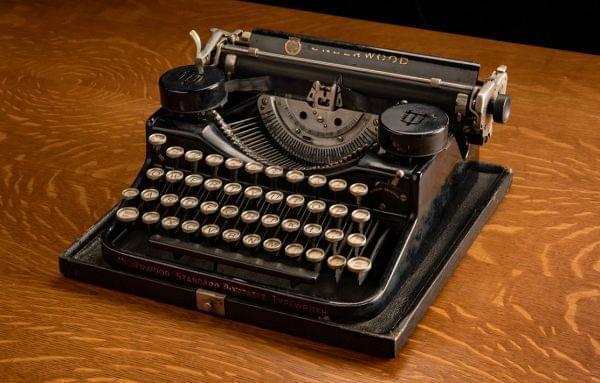U Of I Library Exhibit Features Hefner’s Typewriter And Other Writers’ Tools

An Underwood Standard Portable typewriter used by Hugh Hefner as a student at the University of Illinois and when he worked on the first issues of Playboy. The typewriter, on loan from the collection of Mark Pepitone, is part of the "Writers and Their Tools" exhibit at the University of Illinois Rare Book and Manuscript Library. L. Brian Stauffer/University of Illinois
A new exhibit at the University of Illinois Rare Book and Manuscript Library features the tools that writers have used throughout history to record their words. One of the items displayed at the “Writers and Their Tools” exhibit is a typewriter that belonged to a U of I student named Hugh Hefner.
Hefner (who died in 2017) brought the typewriter, an Underwood Standard Portable, to the Urbana-Champaign campus, where he used it to work on Shaft, a campus humor magazine that he co-published. His daughter, Christie Hefner, says that experience, and the typewriter itself, helped a few years later, when his father started his own magazine, Playboy.
“There’re kind of early iconic pictures of him working in the apartment on the south side of Chicago, where he worked on the first few issues of the magazine with the typewriter,” said Christie Hefner, who ran her father’s Playboy Enterprises from 1988 to 2009.
Christie Hefner is the eldest child of Hugh Hefner, but isn’t old enough to remember the typewriter, which was loaned by a private collector for display at “Writers and Their Tools”. She says her father was probably dictating most of his writing for Playboy during much of her childhood.
“I remember actually using an old Dictaphone in the ‘50’s, and listening to my voice back as a child and thinking that was an amazing sort of technology,” said Christie Hefner.
“Writers and Their Tools” features a range of objects that writers have used over the years to record their words. But at the heart of the exhibit are some typewriters used by notable writers from Illinois. They include a Corona Silent typewriter used by poet Carl Sandburg to write the pieces collected in his 1943 book Home Front Memo, two typewriters (manual and electric) used by novelist James Jones (author of From Here To Eternity and The Thin Red Line) and a typewriter used by film critic Roger Ebert, who wrote and edited at the Daily Illini during his days as a U of I student in the 1960’s. The typewriters are supplemented with displays of some of the manuscripts and copies of the books that were produced on them.
Joining these typewriters and examples of other writing tools, including quill pens, and inkpot and parchment paper, metal type from a printing press, a typewriter with Yiddish characters and a computer hard drive (from a computer used by the writer D.H. Melhem).
Visiting curator Ruthann Miller put “Writers and Their Tools” together for the Rare Book and Manuscript Library”. Miller, whose own background is medieval history, said she learned a lot from the process, including the devotion and loyalty that different writing tools inspired in different people.
“There’s still a trend for people to make handmade parchment and write on it with a quill, and in certain calligraphic styles,” said Miller. “And people still write on typewriters, even though there’s more advanced technology available. The affection that people have for the tools that they use to write, I think that’s what I like best about it.”
Christie Hefner says she’s mindful of the impact that writer’s tools can have on the writing process, and says something has been lost with the move away from physical documents. While most of her writing these days is done on computer, she says she was a journal-keeper from early on, and continues to write in journals from time to time, such as when she’s traveling.
“I actually still very much like writing in long form,” said Hefner. “I find that I’m more reflective when I’m holding a pen and looking at a piece of paper.”
Hefner says that email correspondence feels more “ephemeral” to her than letters on paper. She wonders if today’s electronic writing will be preserved the way that writing on paper has been.
“I think, what will the version of this be in another 20 years?” said Hefner. “Will people have saved their emails? And will they then print them? And will that be what we look at?”
Hefner also regrets how digital manuscripts conceal the editing process, compared to the manuscripts and galley proofs that were once commonly used at magazines like Playboy.
“I feel as if we’ve gotten farther away from insight into the process of writing, compared to when you could see people’s corrections or versions of drafts of things,” said Hefner.
“Writers and Their Tools” is on display in the Rare Book and Manuscript Library on the third floor of the U of I’s main library building through August 30. Christie Hefner was scheduled to visit the exhibit on its opening day, June 17.
Coincidentally, the exhibit is not the only one this summer displaying writing implements with a connection to Hugh Hefner.
The American Writers Museum in downtown Chicago will open “Tools of the Trade”, an exhibit on the same theme, on June 22. The exhibit is sponsored by the Hugh M. Hefner Foundation, and Christie Hefner (the foundation’s president) says another of her father’s typewriters will be displayed there. Despite the sponsorship and the display of Hefner typewriters, Ms. Hefner says both exhibits were conceived by their respective organizers, independently of the Hefner family and foundation.
